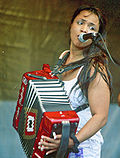| Lists of Americans |
|---|
| By US state |
| By ethnicity |
This is a list of notable Louisiana Creole people .
To be included in this list, the person must have a Wikipedia article showing they are Louisiana Creoles or must have references showing they are Louisiana Creoles and are notable.


























